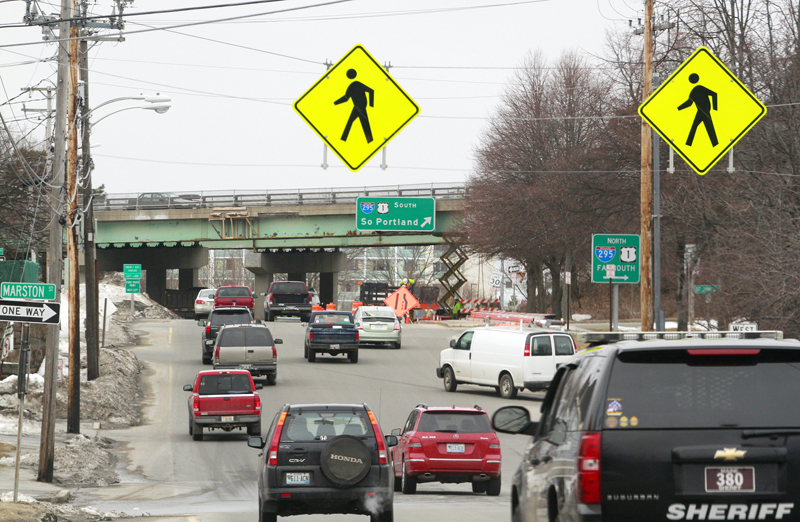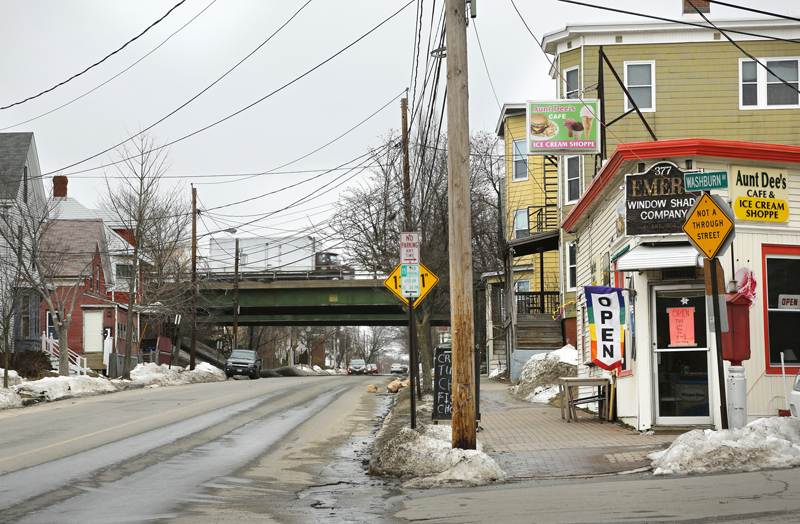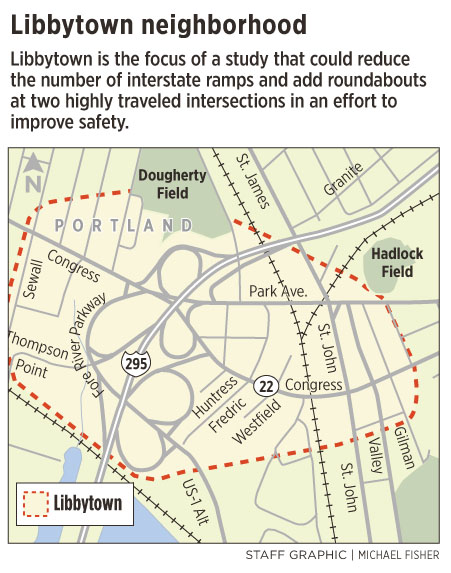PORTLAND — City officials are about to present proposals to revitalize and reconnect Libbytown, a historic neighborhood and a gateway to the city that was bisected decades ago by the construction of Interstate 295.
The city’s staff and consultants have developed five options for making it easier for drivers, pedestrians and bicyclists to get around the interstate’s Exit 5 area. They plan to present options to businesses in the area at a meeting on March 22.
“It’s pretty difficult to negotiate those streets near those ramps if you are a bicyclist or a pedestrian because traffic is moving so quickly,” said Jeremiah Bartlett, the city’s transportation systems engineer.
Two of the neighborhood’s busiest intersections, on Congress Street and Park Avenue, are labeled high-crash locations by the state.
Libbytown was a quieter, more cohesive neighborhood until the early 1970s, when about 100 houses and apartment units were torn down to make way for the highway and interchange. That effectively destroyed the ethnic, working-class neighborhood, said William Barry, a research historian for the Maine Historical Society who co-authored a book about the area.
“The automobile sort of cut Libbytown to shreds,” Barry said.
Now, the city is anticipating a major development at nearby Thompson’s Point, a $105 million mixed-use project that is expected to draw visitors from around the region and increase traffic.
The new focus on Libbytown is the latest of several projects around Portland that seek to make urban streets more pedestrian- and bike-friendly, rather than just a way to move large amounts of traffic.
Other “Complete Street” projects include an effort to convert High and State streets from one-way to two-way traffic, and an effort to redesign Franklin Street.
A team of consultants, along with the city, the Portland Area Comprehensive Transportation System and a public advisory group, has been studying ways to improve Libbytown since November. The $100,000 study is being funded by PACTS.
Libbytown is generally considered the area of Park Avenue and Congress Street bordered by Sewell Street, the Fore River and Gilman Street. It is named after George Libby, an Irish immigrant who moved to the area in the mid-19th century and owned three businesses there.
The neighborhood has always been considered a gateway to the southern part of the city, according to Barry.
After the Revolutionary War, it was the entry point for major cattle drives from Crawford Notch, N.H., and produce deliveries from Vermont, Barry said. Later, it was a landing area for goods shipped along a canal to Westbrook.
Libbytown also was the home of Union Station, Maine’s transportation hub for much of the 20th century. The station’s 138-foot-tall clock tower greeted tens of thousands of travelers a year.
Once people stopped riding trains and started buying automobiles, Union Station became obsolete. It was torn down in 1961.
When “superhighways” were built, “they basically destroyed the neighborhood,” Barry said.
But Libbytown is still a gateway to the city, said Bartlett. It’s next to Maine Medical Center and Hadlock Field and close to the Portland Transportation Center, the hub for Amtrak’s Downeaster, Concord Coach Lines and the Metro bus service.
Bartlett said the staff has not yet selected a preferred option, but the public advisory group appeared to support including roundabouts — traffic circles — as a safe alternative to current intersections.
With added landscaping or sculptures, roundabouts also would provide an opportunity to make that area a true gateway to downtown Portland, he said.
“It might give people a sense they’re arriving to downtown Portland,” Bartlett said.
Bartlett said a big focus of the plan is the intersection of Congress Street and the Fore River Parkway.
The parkway was built in 2005 to connect Congress Street to West Commercial Street. It is considered underutilized, but that is expected to change if the Thompson’s Point project is developed.
The Forefront at Thompson’s Point is designed to include an arena, a hotel and offices, which would add traffic in the area.
The advisory group also supported converting a one-way section of Park Avenue to two-way traffic, although further study of its impact on the Hood plant is needed, Bartlett said.
The consultants will meet with business owners from 8:15 to 9:15 a.m. on March 22 at Peloton Labs, at 795 Congress St.
Bartlett said the consultants are expected to do a detailed analysis of the options, including costs, and present their findings to the City Council’s Transportation, Energy and Sustainability Committee as early as June.
Carl Eppich, the transportation planner for PACTS, said the final recommendations will also include new bike and pedestrian lanes and new bus stops.
Any changes to the I-295 ramps would need approval from the Federal Highway Administration and the Maine Department of Transportation.
“It’s easy to look at these drawings on paper and think they’re going to be a panacea and solve everyone’s problems,” he said. “We need to go through a process to vet them.”
Randy Billings can be contacted at 791-6346 or at:
rbillings@pressherald.com
Twitter: @randybillings
Send questions/comments to the editors.






Comments are no longer available on this story